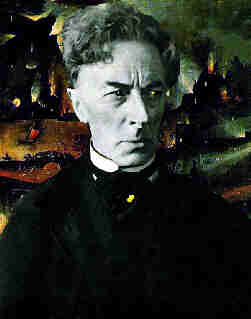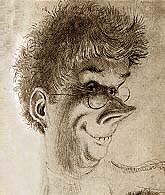The Doctor is In!

Here is the eccentric Ernest Thesiger as Dr. Septimus Pretorius in James Whale's masterpiece Bride of Frankenstein. Hieronymus Bosch supplies a suitable backdrop for this sinister individual.
Few people realize the
extent to which the character of Dr. Pretorius was modeled on
that of Paracelsus, a famous alchemist and physician who roamed
the troubled countryside of 16'th century Europe. Paracelsus was
credited with the creation of homunculi,
diminutive human-like creatures, which he formed out of human
seminal fluid. In her novel Frankenstein,
Mary Shelley lists Paracelsus as exerting a major influence on
the mind of the young Victor Frankenstein, and James Whale
incorporates a number of allusions to Paracelsus in Bride
of Frankenstein.
Today, Dr. Pretorius has
become a popular figure in the gay community primarily due to
David Skal's contention (in his book The
Monster Show) that the Pretorius character
was a homosexual. However, this interpretation of the good
doctor's sexual preferences is much too tame. As I argue in my
article "Of Gods and Monsters: A Pathology Report on Dr.
Pretorius," in Midnight Marquee #56, Pretorius
was a necrophile with a penchant for sexual mutilation.
Pretorius's necrophilia
is made quite apparent in Bride of
Frankenstein's crypt sequence, where we see
the withered scientist unpack a picnic meal on top of the coffin
which he and his henchmen have just rifled. But Whale provided
other hints in the film, one of which was cut out by censors. The
dialogue from this scene, transcribed from memory by Forry
Ackerman in Famous Monster's #21 (pp.
44-45) runs as follows:
(Pretorius is explaining why he was kicked out of the University.) "Actually it was a very small matter, a question of taking a corpse out of the mortuary. You know how difficult it is to get cadavers for dissections...there was some trouble about it. It happened that the lady--oh, I forgot to tell you it was a lady--was in the habit of suffering from cataleptic fits. Her townspeople were quite aware of her malady, but on her first day here in our town of Frankenstein she was seized with a fit in the marketplace and, thinking her dead, they placed her in the mortuary!"
"But how terrible!" Henry exclaimed. "And she was not dead at all?"
"So they said. But how was I to know?'
"But there were signs, surely?'
Pretorius nodded nonchalantly. "To be sure--when one is looking for them. Curiously enough, I did think the body rather warm before I started dissecting."
Frankenstein was now thoroughly horrified at the recital. "And you paid no attention?"
"It never occurred to me to realize what had happened. And then, when she did recover, it was too late to do anything about it. You see, I had done quite a lot of dissecting before she screamed...Afterward, I did the only merciful thing."
![]()
This ghastly account makes one wonder just how ignorant of the signs of life Pretorius really was when he started to dissect the unfortunate woman. One suspects he enjoyed the whole nightmarish experience!
 I've always had a soft
spot for Dr. Pretorius, and have often wondered if Mervyn Peake,
in his fantasy epic The Gormenghast Trilogy,
patterned Dr. Prunesquallor after Bride of
Frankenstein's maddest doctor. Peake's
drawing of Prunesquallor, seen at left, looks just like Thesiger in
his role as Pretorius.
I've always had a soft
spot for Dr. Pretorius, and have often wondered if Mervyn Peake,
in his fantasy epic The Gormenghast Trilogy,
patterned Dr. Prunesquallor after Bride of
Frankenstein's maddest doctor. Peake's
drawing of Prunesquallor, seen at left, looks just like Thesiger in
his role as Pretorius.
Learn more about Ernest Thesiger by reading "The Importance of Being Ernest" at The Missing Link website.
Return to Reflections